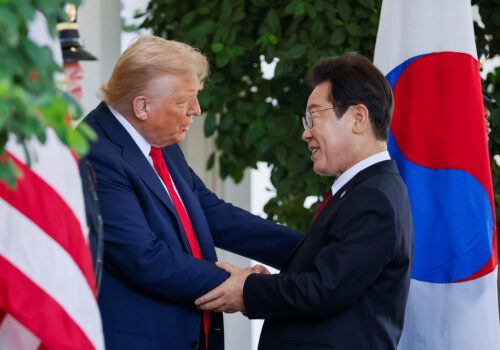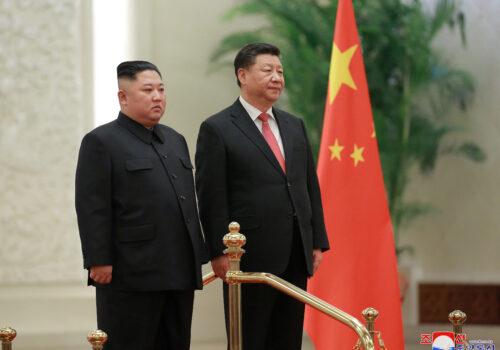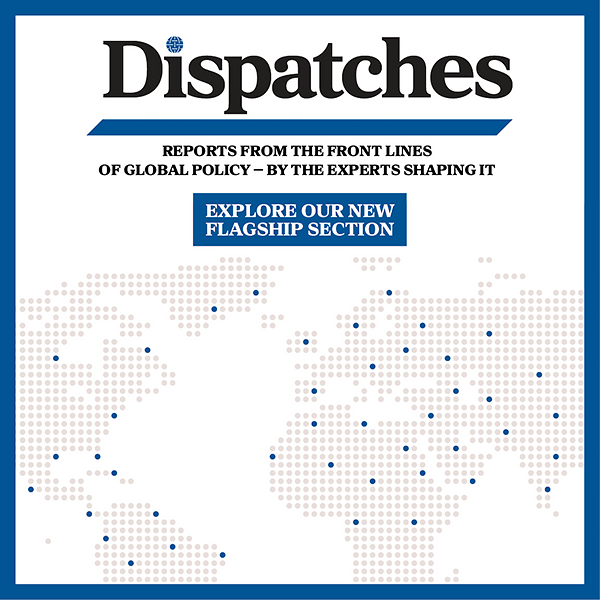Navigating the new normal: Strategic simultaneity, US Forces Korea flexibility, and alliance imperatives
Bottom lines up front
- Seoul should anticipate a possible transition of US Forces Korea toward fewer ground forces and a more flexible US presence overall.
- Mismanaging such a transition risks alliance fatigue, fragmentation, or hollow deterrence.
- US demands should not be depicted as unilateral disengagements but as catalysts to deepen conventional-nuclear integration of the alliance, seek new assurances, and refine the division of labor to create a more adaptive and credible alliance.

The recent summit between South Korean President Lee Jae-myung and US President Donald Trump, despite looming anticipation of large-scale changes in the alliance, such as restructuring of US Forces Korea (USFK), ended with Trump touting his “very good relationship” with North Korean leader Kim Jong Un. Yet as Trump hinted about seeking “ownership” of military bases, his demands for greater burden-sharing from Seoul remain. This particularly reflects Washington’s apparent shift toward a “China-first” strategy as reportedly outlined in the Interim National Defense Strategic Guidance. South Korea can expect continued pressure to assume greater regional security responsibilities, with alliance discussions over key issues such as troop reduction, strategic flexibility, and wartime operational control (OPCON) transfer. Echoing the latest call of Markus Garlauskas, director of the Indo-Pacific Security Initiative of the Atlantic Council’s Scowcroft Center for Strategy and Security, to upgrade the ROK-US alliance from “ironclad” to “titanium,” I also contend in this paper that the brewing changes in the alliance can provide momentum for a renewal befitting the changing security environment. With specific focus on the possibility of USFK reduction or adjustments, I contend that while strategic simultaneity fragments traditional alliance roles, it also generates new imperatives and opportunities for conventional-nuclear integration and refining the division of labor to create a more adaptive and credible alliance.
Strategic simultaneity and USFK transformation
The concept of strategic simultaneity has posed new questions for alliance structures. Amid rising tensions with both a US nuclear peer and a near peer—the Russian Federation and the People’s Republic of China—the Democratic People’s Republic of Korea (DPRK) also is expanding its nuclear weapons capabilities, assisted by its mutual defense pact with Russia. These factors demand the sustained attention and readiness of US forces in the Indo-Pacific. Meanwhile, the US military has ongoing commitments of support for Ukraine and in the Middle East, leading to a reprioritization of resources.
Faced with such a congested security environment, the US military presence on the Korean Peninsula appears to be at the edge of transformation. The Wall Street Journal, for instance, reported in May that the approximately 4,500 troops of USFK’s Stryker Brigade Combat Team (SBCT)—which currently rotates into South Korea every nine months—could be withdrawn for possible redeployment to Guam or even the US southern border for domestic missions. The retirement of twenty-four A-10 aircraft by September 2025 also necessitates reconfiguration of the forces.
In Seoul, these possible USFK adjustments arouse concerns, particularly given the backdrop of Trump’s approach to alliances. The withdrawal of the SBCT, for instance, would leave the Eighth Army—which commands US Army forces in South Korea—without any maneuver elements. Although artillery, Apache helicopters, missile defense units (e.g., Patriot and Terminal High Altitude Area Defense, or THAAD), and intelligence, surveillance, and reconnaissance (ISR) platforms are expected to remain, this shift increases the burden on the ROK military to fill operational gaps, especially in early-phase ground operations. The Stryker team, designed for rapid response and equipped with real-time targeting sensors, plays a key role in ground warfare; its absence would degrade US immediate tactical responsiveness in South Korea.
Moreover, there is growing concern in Seoul about US interest in enhancing USFK’s strategic flexibility to address contingencies beyond the Korean Peninsula. Although key military leaders including the chairman of the Joint Chiefs of Staff, General John D. Caine, the USFK commander, General Xavier T. Brunson, and the commander of the Indo-Pacific Command, Admiral Samuel Paparo, have publicly underscored the continuing need for the US presence on the Korean Peninsula for credible deterrence against North Korea, the issue of strategic flexibility is reemerging as a critical topic within the alliance.
This is particularly true amid Washington’s prioritization of its military readiness vis-à-vis China. Under Secretary of Defense Elbridge Colby, currently leading the drafting of the Pentagon’s National Defense Strategy, has repeatedly emphasized—prior to entering office—the need to reorient USFK to better address what he regards as the primary threat: China. Robert Peters, a senior fellow at the Heritage Foundation, has also recently urged that “all geographic combatant commands should be directed to plan for a China contingency.” Such calls underscore the United States’ growing strategic rationale behind transforming USFK into a force better aligned with transregional deterrence priorities. The United States has reaffirmed the ROK-US alliance as “ironclad,” as Secretary of State Marco Rubio put it, and emphasized the alliance’s capacity to “continue to thrive” under Seoul’s new leadership of President Lee Jae-myung. Yet the US perception of a congested threat environment in the Asia-Pacific region, its priority focus on China, and its vision of a more flexible USFK all point to the potential for alliance fissure.
New mission for alliance: Strategic reconfiguration
In short, Seoul should anticipate a possible transition toward fewer ground forces and a more flexible US presence. Washington’s increasing emphasis on airpower and missile defense over heavy ground units suggests a redefinition of US priorities in the region. The upcoming withdrawal of legacy platforms and restructuring of USFK may reflect this shift. The current administration’s apparent interest in the transfer of wartime operational control will accelerate such a shift.
What’s important for the alliance, however, is to ensure that the transformation constitutes a strategic reconfiguration rather than fragmentation. Both Seoul and Washington’s stakes are too high to diminish deterrence and the extended deterrence values of the alliance. Therefore, even though US military forces are stretched thin in a multi-adversary environment, Seoul does not have the luxury of foregoing the combined deterrence and extended deterrence mechanisms of the ROK-US alliance. The DPRK’s continued nuclear threats, the revived DPRK-Russia mutual defense pact, and China’s increasing encroachment at sea and air have also congested Seoul’s security environment.
To reconfigure the alliance without risking a kind of deterrence vacuum on the Korean Peninsula, Seoul and Washington should pursue new initiatives for conventional-nuclear integration and refined division of labor in the region. To elaborate, since the 2023 Washington Declaration and the establishment of the Nuclear Consultative Group (NCG), South Korea and the United States have focused on improving the conventional-nuclear integration (CNI) of their forces, including US nuclear weapons. For South Korea, the motivation behind pursuing CNI has centered on two key objectives. First, CNI enables the ROK to specify and expand its conventional role, by which it can seek to better lock in the US security commitment to provide, per the State Department’s NCG fact sheet, the “full range of US capabilities including nuclear.” Second, by delineating its conventional responsibilities, South Korea can upgrade both its operational and hardware capabilities. Altogether, CNI is an effort to signal the alliance’s credible resolve and capability to deter DPRK.
First and foremost, this CNI context would enable Seoul to ensure that any reduction of USFK troops or withdrawal of US legacy platforms is followed by the United States’ continued provision of extended deterrence and also to push for new US assurance measures. Seoul should seek to reaffirm the declaratory policy that, should North Korea employ nuclear weapons in an attack, the United States will employ “the full range of US capabilities” and bring about “the end of the Kim regime.” Sustaining the operation of key deterrence coordination mechanisms such as the Extended Deterrence Strategy and Consultation Group and NCG, as well as regular maintenance of combined training and exercises, will be critical.
Second, regarding capability, the legacy platforms can be replaced with new and advanced capabilities. Indeed, with the retirement of the A-10 aircraft, there is proposed permanent deployment of one F-35A squadron at Kunsan Air Base, with rotation of another squadron. The F-35, with its stealth and electronic warfare capabilities, offers better survivability and precision strike options against critical targets than the A-10. Technologically, it surpasses the F-16 in versatility, integrating electronic warfare and electro-optical/infrared (EO/IR) sensor suites for multi-role missions. More importantly, the anticipated deployment of F-35As may be a window of opportunity for Seoul and Washington to discuss possible utilization of F-35As for dual-capable aircraft (DCA) missions—given their capability of deploying and operating US tactical nuclear weapons. Flexible and temporary deployment of US tactical nuclear weapons, as well as Seoul’s participation in DCA missions, could be the next steps of alliance transformation as well. Moreover, the United States also is prepping for consolidation of sixty-two F-16s into two “super squadrons” at Osan Air Base (one super squadron is already in place). The consolidation of the F-16 fleet into super squadrons reflects a new US approach to maximizing combat readiness by integrating aircraft and personnel for rapid, high-intensity operations. For Seoul, such consolidation at Osan Air Base would shorten response times to North Korean threats by more than 100 kilometers—e.g., Kunsan to Kaesong in 5 minutes 20 seconds at Mach 2, Osan to Kaesong in 2 minutes 30 seconds. Its effect on the adversary is already salient as Rodong Sinmun, the official Party newspaper of North Korea, in May condemned the first super squadron’s establishment as “a dangerous military move aimed at preemptive strikes against our state.” In addition, with Trump’s push for a missile defense system dubbed the Golden Dome—with an earmark of $25 billion in the FY2026 defense budget—Seoul may also seek to reinvigorate missile defense cooperation. As recent Israel-Iran conflict demonstrated, missile defense is not only a central means to enhance deterrence (and extended deterrence) by denial but also to damage limitation and survivability or resilience if deterrence fails.
Third, aside from capabilities, thinking about a larger scope of deterrence beyond the Korean Peninsula may be necessary for Seoul as well. As the US burden to deter multiple, simultaneous threats grows heavier, it serves South Korea’s strategic interest to actively contribute to efforts aimed at reinforcing the credibility and resilience of US regional deterrence, including its nuclear umbrella. While Seoul remains committed to its preference for a Korean Peninsula-centric posture, it must also recognize that reluctance to engage in broader regional deterrence initiatives may weaken US resolve, erode deterrence coherence, and embolden adversaries to exploit perceived gaps, especially under Trump’s approach to alliances.
Last but not least, the transformation of USFK—and the broader evolution of the ROK-US alliance—will serve as a powerful external driver compelling Seoul to undertake a comprehensive overhaul of its national defense posture. As USFK shifts toward a more agile and airpower-oriented configuration, with fewer ground forces, the onus will fall increasingly on South Korea to fill capability gaps across multiple domains. This will likely require a significant increase in defense spending, acceleration of military procurements, and deep structural reforms in force structure, doctrine, and training—particularly in areas such as ISR and missile defense. Close strategic synchronization—as urged by Ham Hyeong-pil, director for the Center for Security Strategy at the Korea Institute for Defense Analysis—with an evolving US force posture would help secure Washington’s continued political and operational support for Seoul’s force modernization efforts. Above all, strategic synchronization will be critical to ensure that any reduction in the scale or change in role of USFK does not lead to a deterrence vacuum, which could embolden adversaries such as North Korea, China, or even Russia to test the credibility of the alliance.
Conclusion
The second Trump administration’s priorities and the evolving reality of strategic simultaneity—exacerbated by the growing threats from North Korea, China, and a realigned Russia bolstered by North Korean military support—have ushered in an era of transformation for the ROK-US alliance. As Washington reallocates both attention and US military assets toward transregional challenges, Seoul faces mounting pressure to absorb a greater share of operational responsibility, strategically recalibrate its force posture, and align its defense planning with a shifting alliance architecture. If mismanaged, this shift could lead to alliance fragmentation, fatigue, or hollow deterrence. However, as this article contends, if managed carefully and strategically leveraged, the anticipated transformation of USFK presents Seoul with a critical window of opportunity: to deepen the alliance’s CNI, refine the division of labor, and lay the foundation for a more adaptive and strategically credible alliance.
The future of deterrence on the Korean Peninsula—and indeed, the wider Indo-Pacific region—will hinge on Seoul’s ability to reframe US force realignments not as unilateral disengagements but as catalysts for indigenous capability development, coevolution in defense planning, and new forms of assurance through extended deterrence mechanisms.
About the author
Related content
Explore the program

The Indo-Pacific Security Initiative (IPSI) informs and shapes the strategies, plans, and policies of the United States and its allies and partners to address the most important rising security challenges in the Indo-Pacific, including China’s growing threat to the international order and North Korea’s destabilizing nuclear weapons advancements. IPSI produces innovative analysis, conducts tabletop exercises, hosts public and private convenings, and engages with US, allied, and partner governments, militaries, media, other key private and public-sector stakeholders, and publics.
Image: US Army photo by Cpl. Philemon Tan




